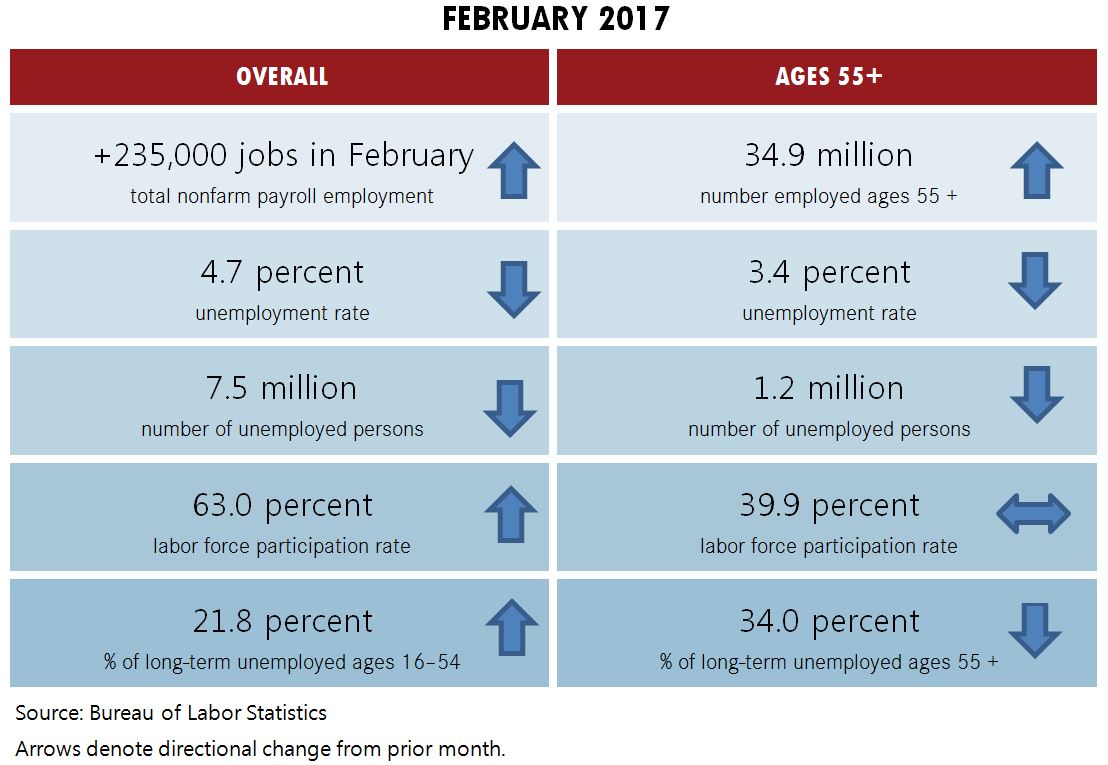AARP Hearing Center
Job Numbers Rise but Labor Force Participation of Those Ages 55+ Holds Steady
By Jennifer Schramm, March 10, 2017 05:55 PM

Employment overview for those ages 55+
The monthly Employment Situation Report from the Bureau of Labor Statistics (BLS) shows the economy added 235,000 jobs in February 2017. While the number of those ages 55-plus who are employed rose slightly in February, this age group’s labor force participation rate (i.e., the percentage of the population that is either working or actively seeking work) held steady at 39.9 percent. The labor force participation rate of persons ages 55 and older has remained around 40 percent throughout the past year. Meanwhile, the unemployment rate for those age 55 and above was down marginally at 3.4 percent with approximately 1.2 million unemployed.
Trends in labor force participation rates beyond traditional retirement age
While there has been little movement in the labor force participation rate of older Americans over the past year, over the longer term the percentage of workers participating in the labor force past traditional retirement age has fluctuated significantly. In 1948 the labor force participation rate of those ages 65-plus was 27 percent, according to the BLS. Over the following decades it declined steadily, reaching as low as 10.8 percent in 1985.
Much of this change was driven by declining participation rates among older men. This downward trend was likely due to several factors, including greater access to employer-based retirement benefits such as pensions as well as Social Security and Medicare. Improvements in the postwar economy also helped Americans save more for retirement.
However, recent decades have seen the participation rate reverse course and slowly begin to rise. Behind this reversal are changes in the economy, policy and demographics. Wages have not maintained the upward trajectory of the postwar boom years, making it more difficult for some individuals to save more of their income for retirement. The displacement of traditional pensions with defined contribution plans has also likely contributed to rising labor force participation at older ages. Meanwhile, rising average life spans have meant that retirement assets — savings, employer-provided pensions and defined contribution plans, and Social Security — need to cover a longer period of time spent in retirement. Longer and healthier life spans also make it possible for some individuals to work beyond traditional retirement age. Gains in higher education are also associated with longer working life spans. Meanwhile, the gradual increase in the full retirement age for obtaining Social Security benefits from 65 to 67, among other changes to the program, has encouraged many individuals to continue to work after 65. By 2016 the annual average participation rate for those ages 65-plus had reached 19.3 percent.
The steady increase in boomers exiting the labor force is expected to lower the overall participation rate of those 55 and over. But the factors that drove the postwar decline and, conversely, the increase in labor force participation of those 65 and older in the 1990s will continue to influence how many Americans work beyond traditional retirement age.
For more of this month’s employment data on Americans ages 55 and over, check out PPI’s Employment Data Digest.
































































